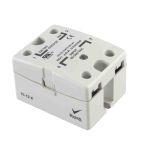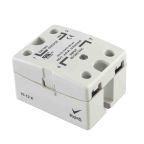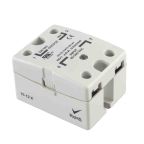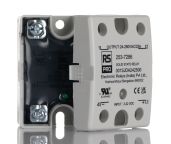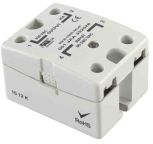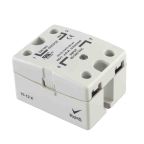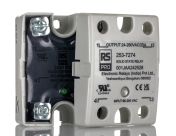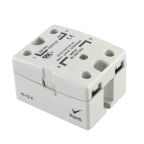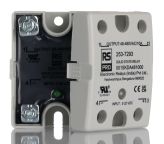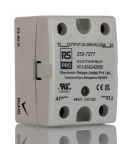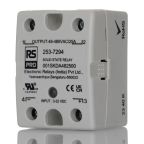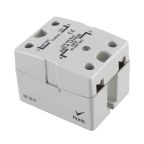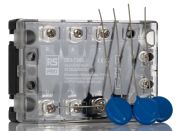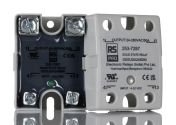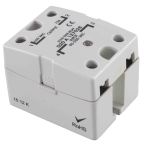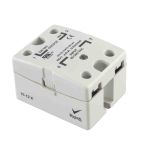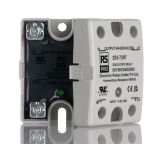Solid State Relays
Solid state relays, or SSRs are electrical switching devices that serve the same purpose as monitoring relays, but without the moving parts hence the name 'solid state'. By having no moving parts, the SSR tends to have a longer operational lifetime as they are not subjected to wear and tear.
Solid state relays can switch faster than their electromechanical counterparts, as they use the electrical and optical properties of semiconductors to perform the switching functions. RS offers an extensive range of solid state relays for sale from trusted brands, including Celduc, Sensata/ Crydom, Omron, Phoenix Contact, and many others. Get in touch to order and buy electronic relays at competitive prices or to find out more about our products and services.
Types of Solid State Relays
Solid State Relays (SSRs) come in various types, each designed for specific applications. When you understand these types and their functions, you can select the right SSR for your project.
AC Output Solid State Relays
AC output SSRs are ideal for controlling alternating current loads. They're commonly used in industrial heating systems, lighting control, and HVAC equipment.
Key Features:
- Zero-crossing switching to minimise electromagnetic interference
- Typical voltage ratings: 24-280VAC
- Typical current ratings: 0.1A to over 100A
These SSRs excel in managing AC loads, significantly reducing electromagnetic interference thanks to their zero-crossing switching capability, making them valuable in sensitive electronic environments.
DC Output Solid State Relays
DC output SSRs are designed specifically for switching direct current loads. They find their niche in applications like battery charging systems, solar panel installations, and DC motor control.
Key Features:
- Fast switching speeds, often operating in microseconds
- Typical voltage ratings: 3-200VDC
- Typical current ratings: 0.1A to 40A
The rapid response time and efficient switching capabilities of these solid state relays make them invaluable for precision control applications, catering to a wide array of DC-based systems.
AC/DC Output Solid State Relays
These versatile SSRs can handle both AC and DC loads, offering flexibility that is particularly useful in complex control systems and renewable energy installations that combine AC and DC components.
Key Features:
- Dual functionality reduces inventory needs
- Wide range of voltage and current ratings
- Suitable for multi-purpose industrial control systems
By offering dual functionality, AC/DC Output SSRs can streamline operations for businesses that deal with diverse electrical systems.
Where Are Solid State Relays Used?
When used in tandem with equipment such as signal conditioners, SSRs are applicable across a wide range of industrial settings such as industrial control, robotics, data acquisition, medical equipment, and data acquisition. They are used to control power delivery for lighting, heating, motion-based equipment as well as numerous other applications due to the highly diverse nature of the SSR.
What Are the Advantages of a Solid State Relay?
The main advantages of SSR relays over conventional electro-mechanical relays is that they have no moving parts to wear out, and therefore no contact bounce issues. SSRs can switch both ON and OFF much faster than a mechanical relay armature can move, as well as zero voltage turn-on and zero current turn-off, eliminating both electrical noise and transients.
Key Specifications to Consider When Choosing Solid State Relays
When selecting a solid state relay (SSR), consider these key specifications to ensure optimal performance and reliability.
- Input Voltage Range: The input voltage range determines the control signal voltage needed to activate the SSR, and needs to match your existing control system. Common ranges are 3-32VDC for DC control and 90-280VAC for AC control.
- Output Voltage Rating: This specifies the maximum voltage the solid state relay can switch. AC output SSRs have a typical rating of 24-280VAC, while DC output SSRs range from 3-200VDC. The output voltage rating must exceed the load voltage for safety and performance.
- Current Rating: The current rating indicates the maximum current the SSR relay can handle without overheating. Choose an SSR with a rating at least 20% higher than your load's maximum current to accommodate spikes and ensure longevity. Consider derating for high-temperature environments, as solid state relays may not perform at full capacity in elevated temperatures.
Solid State Relays vs. Electromechanical Relays
Not sure when to choose solid state relays (SSRs) and when to choose electromechanical relays (EMRs)? Here’s a quick comparison between the two.
SSRs excel in high-frequency switching applications that require fast switching, long life, and silent operation. Their solid-state construction makes them ideal for sensitive environments, although they do experience a small voltage drop and require continuous power to remain on.
SSR features:
- Switching Speed: Extremely fast (microseconds)
- Lifespan: Over 10 million operations, no moving parts
- Noise: Silent operation
- Size: Compact and lightweight
- Power: Requires continuous power to stay on
EMRs, on the other hand, may be preferred for high-power applications or where complete electrical isolation is crucial. They have a lower initial cost and don't experience voltage drop, but their mechanical nature limits their lifespan and switching speed.
EMR features:
- Switching Speed: Slower (milliseconds)
- Lifespan: 100,000 to 1 million operations, limited by mechanical wear
- Noise: Audible clicking during switching
- Size: Bulkier and heavier
- Power: Consumes power only during switching
Ultimately, the choice between SSRs and EMRs depends on your specific application requirements, considering factors such as switching frequency, expected lifespan, environmental conditions, and power requirements.
Industrial Applications of SSRs
Solid State Relays (SSRs) play a pivotal role in a variety of sectors, leveraging their rapid switching, reliability, and durability to enhance the functionality and safety of complex systems. Across Malaysia, industries ranging from healthcare to renewable energy depend on the unique capabilities of SSRs to improve operational efficiencies and maintain stringent safety standards even in high-voltage settings.
Heating & Cooling Systems
In the humid and often sweltering climate of Malaysia, efficient climate control is essential in both commercial and residential buildings. SSRs are particularly effective in managing HVAC systems, enabling precise control over heating elements and cooling fans. For instance, in large shopping malls, SSRs help in segmenting climate control systems to operate independently in different zones, optimising energy use and maintaining ideal conditions throughout the facilities.
Industrial Automation Facilities
SSRs are integral to the smooth operation of automated production lines across Malaysia’s robust manufacturing sector. They control critical machinery components such as motors and actuators with high precision, ensuring that production processes are seamless and free from interruptions. These energy-efficient relays not only boost productivity but also extend the lifespan of the equipment.
Medical Facilities
SSRs ensure the reliable operation of medical devices, which is crucial in settings where patient safety and care are paramount. Fast switching capabilities and minimal electromagnetic interference make SSRs ideal for sensitive medical equipment like MRI machines and patient monitoring systems. SSRs similarly contribute to the reliability of life-support systems and other systems requiring uninterruptible power supply, ensuring they operate without electrical interference that could lead to critical failures.
Food Processing Facilities
Maintaining hygiene and precise temperature control is mandatory to meet health and safety standards in the food processing industry. SSRs are employed in the control of cooking and refrigeration equipment, ensuring that temperatures are precisely managed to prevent spoilage and maintain food safety.
Traffic Control Systems
SSRs enhance the reliability and efficiency of traffic control systems, from busy intersections in Kuala Lumpur to remote areas. Their ability to switch rapidly and reliably ensures that traffic lights and railway signals operate seamlessly, thus preventing accidents and improving the flow of traffic and goods. Their use in railway systems is crucial for the safe and timely operation of trains, particularly in urban transit systems where timing precision is key.
Printing Systems
The printing industry benefits from the precise temperature control afforded by SSRs, which is critical in processes like ink application and lamination. This precise control ensures consistent quality in the production of printed materials, from newspapers to packaging. For instance, in label manufacturing, SSRs maintain the necessary heat levels in press machines to ensure that labels are printed with high fidelity and that adhesives are applied correctly.
Photovoltaic Systems
As Malaysia moves towards renewable energy solutions, SSRs are increasingly used in photovoltaic systems to manage the flow of electricity efficiently. SSRs in solar farms near regions like Penang and Sabah ensure that variations in sunlight and other environmental factors do not disrupt the continuous supply of power, maximising energy production and ensuring the stability of power supplied to the grid.
Popular Searches
Related links
- Infineon Solid State Relay
- ABB Solid State Relay
- solid state relay Single Phase, Pan
- Allen Bradley 156-C1P Series Solid State Relay
- IXYS Solid State Relay Surface Mount
- Allen Bradley 156-C3P Series Solid State Relay
- IXYS Solid State Relay Surface Mount, 10 V Load
- Schneider Electric Harmony Relay Series Solid State Relay DIN Rail Mount
